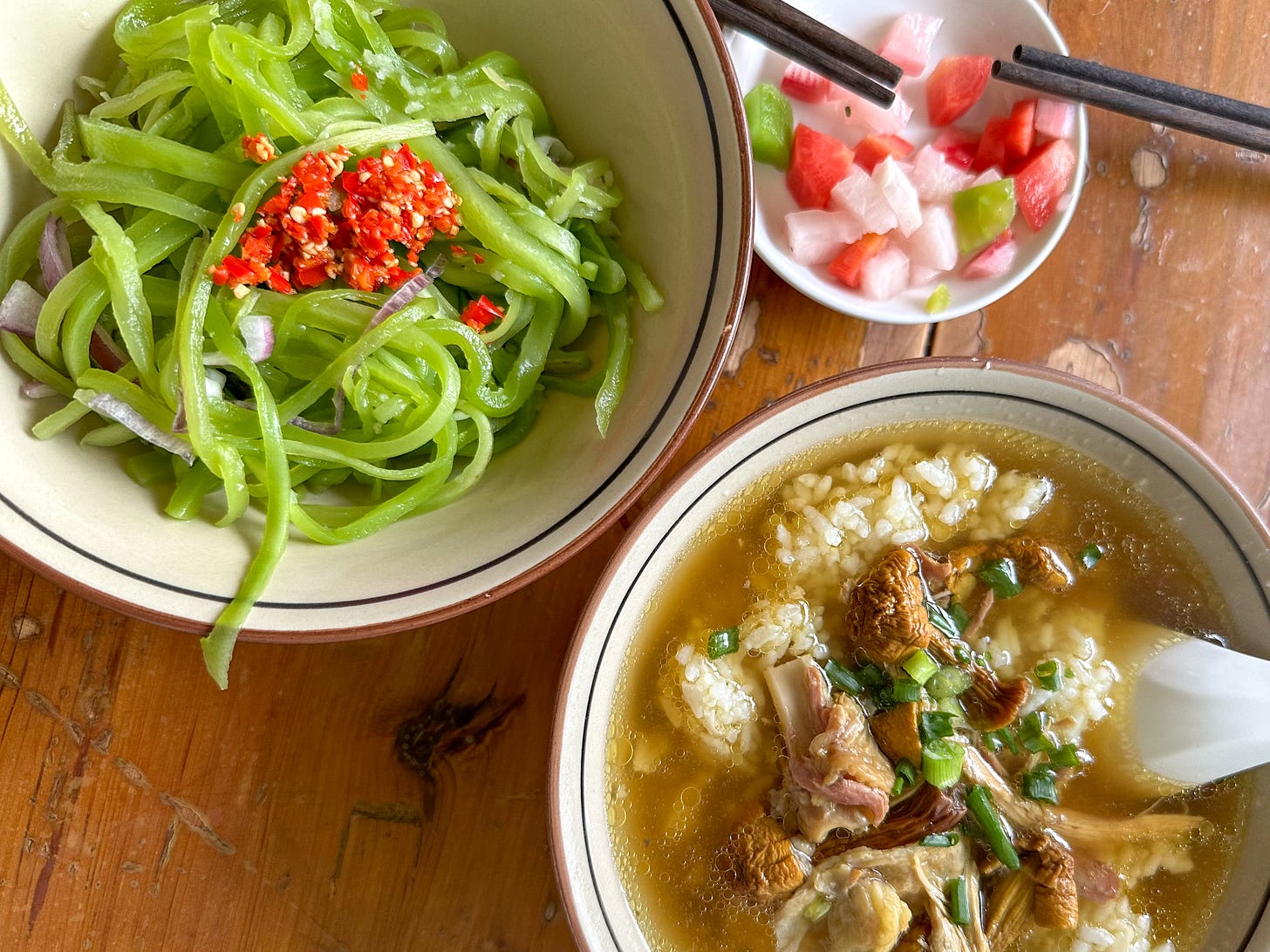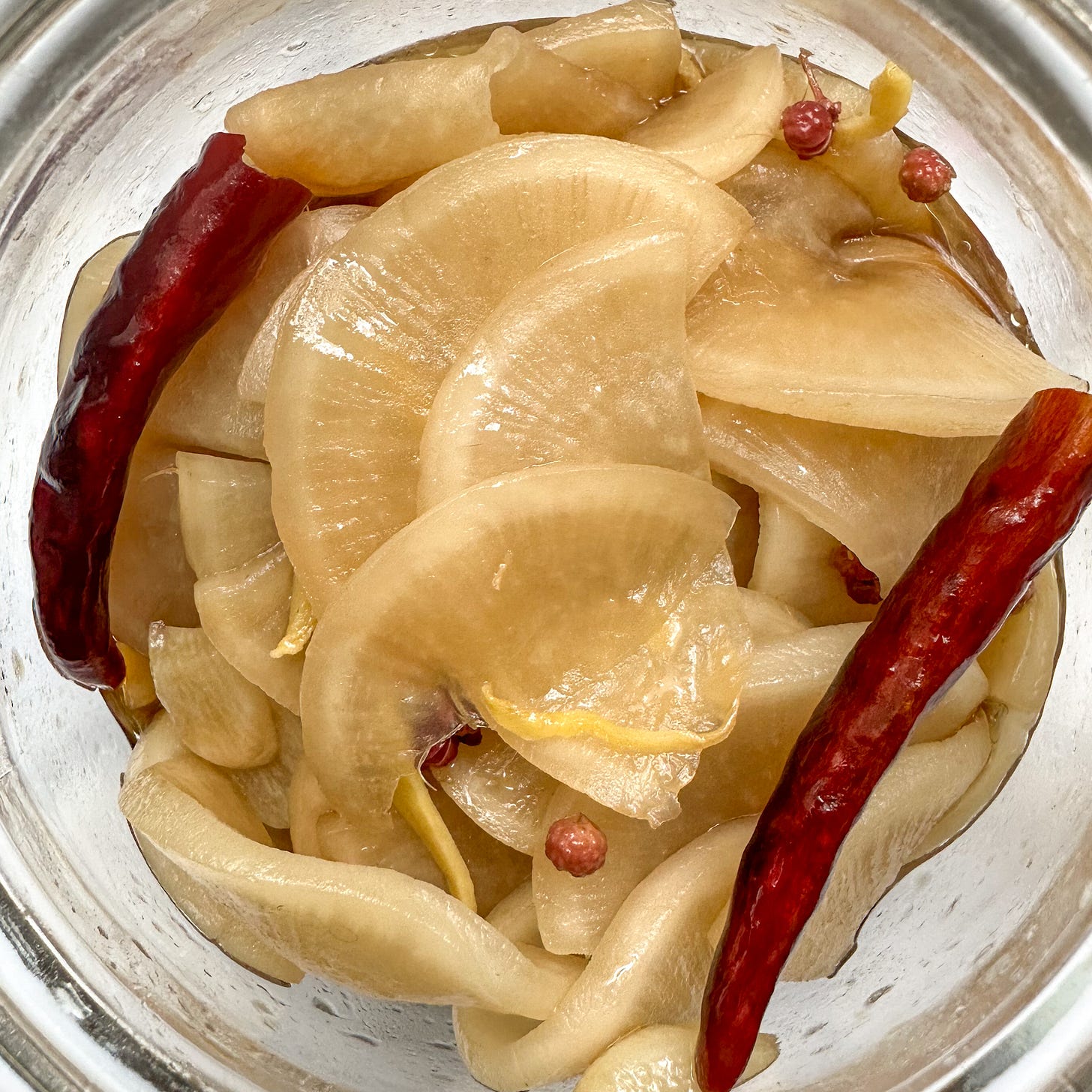Hi! We talked about black vinegar in depth last week, and here’s something approachable and a perfect gateway to incorporating more Chinese vinegar into your cooking repertoire: quick soy-vinegar vegetable pickles.
I love a good old plate of pao cai (Sichuan lacto-fermented pickles), but as this project hasn’t taken off yet, these quick pickles are a solid shortcut: crunchy, appetizing, and refreshing, going well with rice, congee, noodles, and savory oats. Sometimes I put them in a store-bought frozen scallion pancake to make a Jianbing-style wrap. They make excellent accompaniments for a cold beer, especially as I anticipate the upcoming picnic season.
These pickles remind me of the charm of a Chinese food combination: "plain congee and small dishes" (清粥小菜, qingzhou xiaocai). Small dishes consist of pickles, soy-braised dishes, and stir-fries. Back in my hometown, my family frequented an eatery offering a variety of congee and a DIY side dish bar for less than 1 euro. The congee is refillable, and we always got steamed bao buns to make them more filling. Congee and small dishes have been a humble and affordable meal for many in China, and now a comfort food for me when I'm feeling sick or unmotivated to cook.
Quick pickle is more of a casual home-cooking style than a specific dish, going by names like 酱菜 (iiang cai) or 腌菜 (yan cai). You'd find versions made with fruit vinegar, Thai chili, and other spices. This recipe is inspired by the Chinese salad preparation called qiang ban (炝拌): you briefly fry the aromatics and spices in the oil, which adds additional layers of flavor. Then toss together with salt, soy sauce, and vinegar. Sometimes the hot oil is directly poured into the dish. Qiang ban dishes work for blanched potatoes, cabbages, and lotus roots. The flavors are more subtle than directly using minced garlic and chili oil, as in smashed cucumber salad. To keep them crunchy in the fridge, I like to use cucumber and radishes. Common in Asian cuisine, similar variations include Japanese soy pickles (shoyuzuke), Korean pickled radishes (chicken-mu and danmuji), and Vietnamese Đồ Chua for Banh Mi.
I’ve adopted an easy-to-remember ratio of 1:1:1: for 250g of vegetables, you need 1 tbsp of light soy sauce, black vinegar, and sugar each. You can adjust the ratio if you prefer it to be more savory or sour. This recipe works for vegetables such as small radishes, carrots, and kohlrabi.
Watch me make this recipe here!
The recipe
Servings: 2
Ingredients
250 g cucumber(deseeded) or daikon radish
1/2 tsp salt
1 tbsp Chinese black vinegar (preferably Chinkiang)
1 tbsp light soy sauce
1 tbsp sugar
2 cloves of garlic
2 dried chilies
2 slices of ginger
10 whole Sichuan peppercorns
1-2 tbsp vegetable oil
Instructions:
Quarter the cucumber lengthwise, deseed, and cut into sticks approximately 5 cm long and 1 cm wide. If using daikon radish, slice it into half-moon slices about 2mm thick. Salt the vegetables with 1/2 tsp salt and let them sit for at least 30 minutes to draw out excess water. Drain and squeeze out any remaining water.
Thinly slice the garlic and ginger. Clean and deseed the dried chilis. In a small frying pan, heat vegetable oil over medium heat. Add garlic, ginger, Sichuan peppercorns, and dried chilies. Fry until fragrant and the chilies darken in color. Remove from heat and allow the spices to infuse in the oil.
In a mixing bowl, combine the spiced oil with black vinegar, light soy sauce, and sugar. Mix well to ensure all ingredients are evenly incorporated. Adjust seasoning to taste if necessary.
Add the prepared vegetables to the bowl with the marinade. Toss gently to coat the vegetables evenly. Transfer the mixture to a clean, airtight jar or container, press them down or optionally using a weight to ensure the vegetables are submerged in the marinade. Refrigerate overnight to allow the flavors to meld.
Notes on Preparation:
Dried whole chilies provide a subtle heat, but if you prefer more spice, use Thai chilies.
I would recommend Chinkiang for this as it’s really aromatic, however, white rice vinegar can be used as a substitute.
Drawing out excess moisture from the vegetables ensures they maintain their crunchiness. For extra crunchiness, place them on a baking tray lined with paper towels or kitchen towels for a few hours or even overnight until the surface become a bit wrinkly.
This recipe is easily scalable for larger batches and meal-prep. They can be stored in the refrigerator for up to a week or longer.








I've made a batch of both the cucumber and daikon. Thanks for sharing. Very tasty!